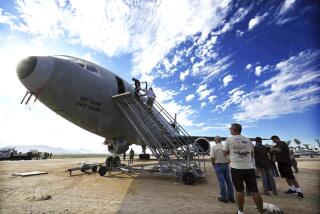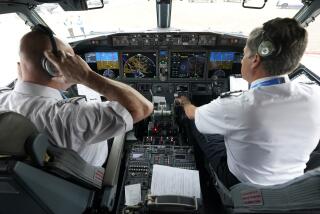House Panel Endorses Guns in Cockpits for Airline Pilots
- Share via
WASHINGTON — Heeding arguments from pilots that they should be the “last line of defense” against airplane hijackings, a key House committee on Wednesday approved a test program allowing them to carry guns in the cockpit.
Although a number of aviation security measures have been enacted since the Sept. 11 terrorist attacks, the Bush administration had decided against letting pilots arm themselves.
But pilot unions responded with intense lobbying on Capitol Hill, and on Wednesday the House Transportation and Infrastructure Committee’s aviation subcommittee approved a measure to create the two-year trial program in which up to 2% of airline pilots--an estimated 1,400--would be trained and deputized as “federal flight deck officers” with authority to carry arms in the cockpit. Flight attendants would receive self-defense training under the bill.
The subcommittee’s approval makes it likely that the full House will pass the measure. But it faces an uncertain fate in the Senate, where the chairman of the Transportation Committee, Sen. Ernest F. Hollings (D-S.C.), adamantly opposes the arming of pilots.
The Bush administration has not taken a position on the proposed program, and the bill’s backers are hoping that the White House can be persuaded to back it.
In a decision announced last month, the Department of Transportation rejected requests to let all pilots carry guns.
The agency contended that pilots should concentrate on flying the plane and leave the job of fending off hijackers to federal air marshals. One of the security-related laws enacted since Sept. 11 has significantly increased the number of marshals assigned to flights.
But pilots inundated Congress with e-mails, letters and phone calls, arguing that guns in the cockpit were a necessary part of heightened aviation security. Rep. Peter A. DeFazio (D-Ore.) even received e-mails sent by pilots while flying, pressing their case.
“Of all the people who look at aviation security, there’s no one that has more experience than a pilot,” said Rep. John L. Mica (R-Fla.), the subcommittee chairman. “Each day they see and they know the weaknesses of the system, and they are asking to arm and defend themselves.”
Republicans are leading the charge against the administration’s decision.
But a number of key Democrats have joined them, saying that guns in the cockpit might be necessary because of the time it will take to put other security measures into effect.
“Until we reach a point where we have a high level of confidence in our passenger screening system, I believe that [pilots have] got a very strong case to make,” DeFazio said.
Pilot unions applauded the panel’s action. Duane Woerth, a Northwest Airlines captain and president of the Air Line Pilots Assn., said the legislation was necessary “in light of the fact that our aviation security system is evolving.”
But Patricia Friend, international president of the 50,000-member Assn. of Flight Attendants, complained that the legislation has “14 pages on cockpit defense, and a page and a couple of sentences on cabin defense.” She said the bill failed to specify what kind of self-defense training flight attendants should receive.
Details of the test program, such as the type of firearms that could be used and where they would be stored, would be left to the Transportation Security Administration.
Pilots would have to undergo background checks, and those who have served in law enforcement or the military would receive preference to participate in the program.
Under the measure, airlines would have no say about their pilots carrying guns. The measure would shield airlines and pilots from liability for any damages from pilots’ using guns in response to a threat.
A number of airlines have lobbied against firearms in cockpits.
But on Wednesday, American Airlines spokesman John Hotard said, “We’re going to do whatever the federal government instructs us to do.”
United Airlines, which has ordered 1,300 nonlethal Taser guns, is seeking the administration’s approval to arm its pilots with the electric weapons.
After a rash of hijackings in the 1960s, pilots were permitted to carry guns if their airline agreed. The program was in effect until July, when the Federal Aviation Administration rescinded it. While the program was in force, only a small number of pilots armed themselves.
The number of air marshals assigned to planes is classified. But in advocating the test program, Mica said it is known that there are not enough marshals to put one on every plane.
“Unfortunately, our aviation system is in a vulnerable stage of transition and will be for some time,” he said.
The subcommittee approved the measure on a voice vote.
Those opposing it included Rep. Eddie Bernice Johnson (D-Texas), who said, “If a hijacking occurs, pilots must concentrate on maintaining control and landing the plane safely as soon as possible and not on confronting terrorists with weapons.”
Rep. Ellen O. Tauscher (D-Alamo) asked, if arming pilots is such a good idea, “why wouldn’t this [panel] insist that every cockpit and all passengers be protected equally?”
“These security measures should benefit everyone, not just those passengers who are on board an airplane with a pilot who happens to be volunteering to carry a weapon that day,” she said.
Tauscher favors arming pilots with nonlethal weapons.
More to Read
Get the L.A. Times Politics newsletter
Deeply reported insights into legislation, politics and policy from Sacramento, Washington and beyond. In your inbox twice per week.
You may occasionally receive promotional content from the Los Angeles Times.











